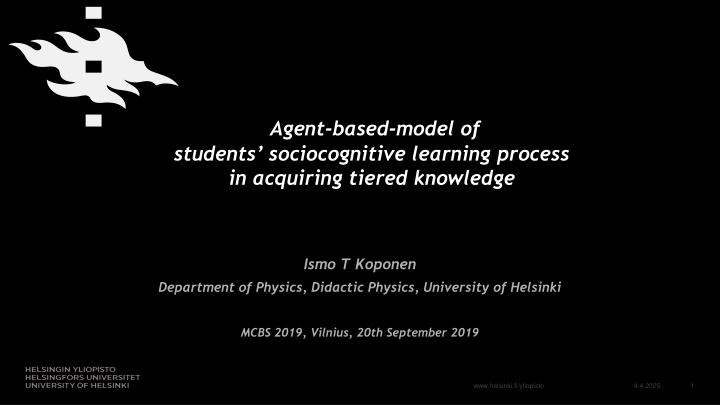
Agent-Based Model of Students' Sociocognitive Learning Process
Explore a study by Ismo T. Koponen at the University of Helsinki on agent-based modeling of students' sociocognitive learning process in acquiring tiered knowledge. The research delves into how students acquire conceptual knowledge, design teaching sequences, make progress, and develop abilities within a teaching-learning sequence. Computational modeling of sociodynamics and a three-tiered system of explanatory schemes are also discussed.
Download Presentation

Please find below an Image/Link to download the presentation.
The content on the website is provided AS IS for your information and personal use only. It may not be sold, licensed, or shared on other websites without obtaining consent from the author. If you encounter any issues during the download, it is possible that the publisher has removed the file from their server.
You are allowed to download the files provided on this website for personal or commercial use, subject to the condition that they are used lawfully. All files are the property of their respective owners.
The content on the website is provided AS IS for your information and personal use only. It may not be sold, licensed, or shared on other websites without obtaining consent from the author.
E N D
Presentation Transcript
Agent-based-model of students sociocognitive learning process in acquiring tiered knowledge Ismo T Koponen Department of Physics, Didactic Physics, University of Helsinki MCBS 2019, Vilnius, 20th September 2019 www.helsinki.fi/yliopisto 4.4.2025 1
Problems of interest P1: How students acquire conceptual knowledge in a teaching-learning process? P1a: How teaching sequences are designed? P1b: How students make progress during teaching sequence? P2: How students abilities or proficiencies develop during teaching-learning sequence and how it affects its dynamics? P3: How social interactions affects and are affected by changes in students abilities or proficiencies? www.helsinki.fi/yliopisto 4.4.2025 2
Computational modelling of sociodynamics of learning: An agent based model D1: Target knowledge description: Epistemic landscape consisting of idealized explanatory schemes; evidence explained and proficiency required to use the scheme. D2:Agent description; proficiency as agent s state, memory. D3: Social dynamics description; self-proficiency and peer- proficiency, appraisals. www.helsinki.fi/yliopisto 4.4.2025 3
4.4.2025 4
A three-tiered system of explanatory schemes: An idealized representation of student s explanatory models (representation of empirical findings) Koponen (2013) Complexity 19, 27-37. Koponen & Kokkonen (2014) Frontline Learning Research 4, 140-166. , www.helsinki.fi/yliopisto 4.4.2025 5
4.4.2025 7
D2: Utility based probabilistic selection of explanatory scheme 4.4.2025 8
D2&D3:Proficiency development on basis social comparisons Bandura s social learning theory transformed to agent based model Leviathan-model describing appraisal based comparisons [Deffuant et al. (2013) Journal of Artificial Societies and Social Simulation 16, 1 28] 4.4.2025 9
The Learning Outcome Attractors (LOAs) for epistemic landscape C. The LOAs are recognised as peaked regions in number density distribution nk for schemes mk, shown as: n1 (orange), n2(blue), n3 (green), n4 (purple) n5 (red). The results are shown at different stages of evolution and for different values of diversity , as indicated in panels. Only densities nk > 0.1 are shown. The darker/lighter shade indicates positive/negative gradients of nk. Matemaattis-luonnontieteellinen tiedekunta / Henkil n nimi / Esityksen nimi 4.4.2025 10
The Learning Outcome Attractors (LOAs) at the intermediate stage of evolution ( = 0.40) compared for epistemic landscape A (no entanglement), B (entangled with = 3) and C (entangled with = 5), from left to right. The LOAs are for schemes mk, shown as: n1 (orange), n2 (blue), n3 (green), n4 (purple) and n5 (red). The results are shown for an intermediate stage of evolution = 0.40 and for diversity = 0.10 (upper panels) and = 0.14 (lower panels), as indicated in panels. Matemaattis-luonnontieteellinen tiedekunta / Henkil n nimi / Esityksen nimi 4.4.2025 11
The Learning Outcome Attractors (LOAs) at the intermediate final of evolution ( = 1.00) compared for epistemic landscape A (no entanglement), B (entangled with = 3) and C (entangled with = 5), from left to right. The LOAs are for schemes mk, shown as: n1 (orange), n2 (blue), n3 (green), n4 (purple) and n5 (red). The results are shown for an intermediate stage of evolution = 0.40 and for diversity = 0.10 (upper panels) and = 0.14 (lower panels), as indicated in panels. Matemaattis-luonnontieteellinen tiedekunta / Henkil n nimi / Esityksen nimi 4.4.2025 12
The total number density of Nk for adoption of schemes mk for epistemic landscape A (no entanglement), B (entangled with = 3) and C (entangled with = 5), from left to right. Total number densities Nk for schemes mk, shown as: N1 (orange), N2 (blue), N3 (green), N4 (purple) and N5 (red). Results are shown for the complete stage of evolution from [0, 1] to and for diversity = 0.08, 0.10, 0.14 and 0.18. Matemaattis-luonnontieteellinen tiedekunta / Henkil n nimi / Esityksen nimi 4.4.2025 13
Comparisons with empirical results? Problem: How in empirical results different effects are collated Empirical settings do not attempt to resolve cognitive and social effects in learning gains effects are explored differently, but in similar settings. Improving empirical settings: 1) Teaching task must be explicitely described; 2) Required proficiencies must be known; 3) Socidynamic interaction patterns need to be known Three different research traditions should be integrated to obtain better resolving power in empirical research. www.helsinki.fi/yliopisto 4.4.2025 14
Interpretations Interpretation of epeistemic landscape as intructional setting Interpretation of dynamicall robust statets as learning outcomes Interpretation of agents structural relations in terms of social learning theory. All interpretation need interpretations of parameters and exogenous variables in terms of features of learners and intructional designs. All interpretations are on basis structural relations between exogeneous variables as compared to hypothetical/observed relations between real learners and their intaractions with instructional environment www.helsinki.fi/yliopisto 4.4.2025 15
Conclusions Agent-based modelling helps: to conceptualise the problem differently, as a complex and entangled problem (as it is) and avoid oversimplifications as separate problems (as it is not) reason about the interdependencies of different phenomena helps to design empirical settings with better resolving power. www.helsinki.fi/yliopisto 4.4.2025 16
